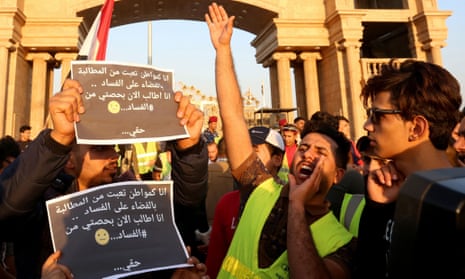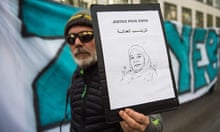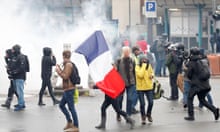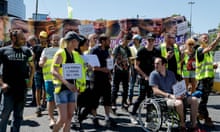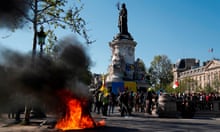It started on 10 October, with a Facebook appeal launched by two fed-up truck drivers from the Seine-et-Marne department, east of Paris, calling for a “national blockade” of France’s road network in protest against rising fuel prices.
Within days the campaign had gathered 200,000 backers and spawned hundreds of local spinoffs across the country; two weeks later, a video urging motorists to display their hi-vis yellow vests behind their windscreens in solidarity garnered 4m views.
The gilets jaunes, named after the vest drivers are required to carry in their vehicles, were born, and since 17 November, the movement’s first nationwide day of action, its sustained, sometimes violent protests have rocked France.
But not only France. Mostly leaderless, unstructured and organised on social media, “yellow vest” demonstrations have multiplied internationally, from Belgium to Bulgaria, Serbia to Sweden and Israel to Iraq.
The popular anti-establishment insurrection by France’s squeezed middle, living mostly in rural or deindustrialised areas and small or medium-sized towns far from the globalised cities where the wealth of the 21st century is increasingly concentrated, has found a global echo.
As in France, where it has overwhelming public support, these diverse national movements have brought together people with disparate demands and political views but one overriding and common complaint: they cannot make ends meet.
“If the hike in the price of fuel triggered the yellow vest movement, it was not the root cause,” said the geographer Christophe Guilluy. “The anger runs deeper, the result of an economic and cultural relegation that began in the 80s … Western elites have gradually forgotten a people they no longer see.”

Cheap, readily available, easily identifiable and above all representing an obligation imposed by the state, the the yellow hi-vis vest itself has proved an inspired choice of symbol and has plainly played a big part in the movement’s rapid spread.
“The point, remember, of the yellow vest is to ensure its wearer is visible on the road,” Guilluy said. “And whatever the outcome of this conflict, the gilets jaunes have won in terms of what really counts: the war of cultural representation. Working-class and lower middle-class people are visible again.”
The revolt spread first to French-speaking Belgium, where 400 people have been arrested over the past few weeks as police used teargas and water cannon to disperse crowds pelting them with flares, cobblestones and billiard balls, and setting cars and trucks alight in Brussels, Charleroi, and elsewhere.
Dismissive, like their counterparts in France, of all their country’s established parties, Belgium’s gilets jaunes, who have demanded the resignation of the prime minister, Charles Michel, aim to launch a Mouvement citoyen belge (Belgian citizens’ movement) to compete in next year’s European and Belgian federal elections.
There have been largely peaceful yellow vest protests in half a dozen Dutch cities including Rotterdam, where marcher Ieneke Lambermont said her children had to “pay taxes everywhere, and can’t get housing anymore”. Things were “not going well in Dutch society”, she said. “The social welfare net we grew up with is gone.”
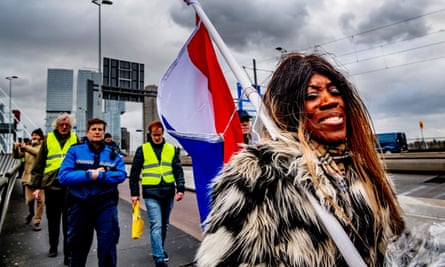
In Italy an anti-austerity, anti-EU protest group inspired by the gilets jaunes has garnered thousands of supporters online and plans a large rally in January, while in Spain Facebook groups of chalecos amarillos plan to begin demonstrating in Madrid in the new year because “it’s worse here than in France”.
Protesters wearing yellow vests have also been seen in Sweden, Greece and the UK, where a group of pro-Brexit campaigners blocked Westminster Bridge and on Wednesday at least two accosted the pro-European Tory MP Anna Soubry outside parliament. In Germany, both the far right and the far left organised yellow-vest protests – separately – in Berlin and Munich.
More than 100 protesters turned up for an anti-government yellow-vest demonstration in Dublin. In Poland yellow-vested farmers blocked the main A2 motorway 20 miles from Warsaw, complaining over a range of grievances.
Protesters wearing yellow vests in Bulgaria, the EU’s poorest member, have blocked major roads including the border crossings with Turkey and Greece, demanding not just cheaper fuel and higher living standards but the departure of a government they likened to “the mafia”.
A civil rights organisation and far-right politicians have adopted yellow vests – for different reasons – in Serbia, while beyond Europe gilets jaunes protests have also occurred in Canada (over the UN migration pact), Israel and Jordan (over corruption and the high cost of living).
In Tunisia, a Facebook group of gilets rouges is complaining about the country’s ailing economy; in Basra, Iraq, gilets jaunes have been protesting against high unemployment, corruption and the terrible general state of the city; and authorities in Egypt are so worried about the movement spreading they have banned sales of yellow vests.
